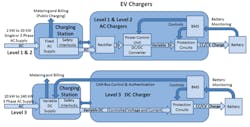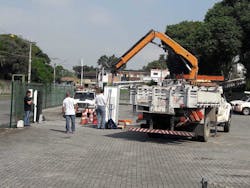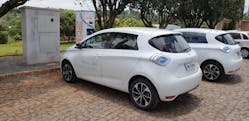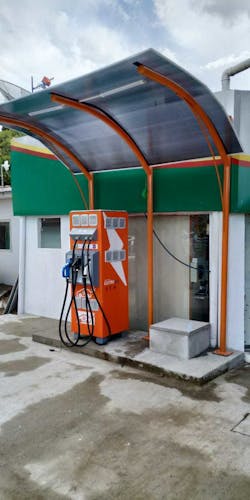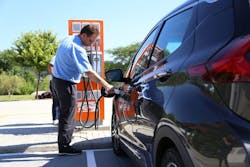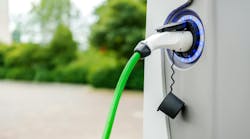Although vehicle combustion has experienced a great evolution over the last several decades, it still is regarded as a major problem in terms of greenhouse gas emissions. Brazil emitted 2.175 billion tonnes of carbon dioxide equivalent in 2019, according to the Brazilian Climate Observatory, and that figure is rising primarily because of deforestation of the Amazon. Therefore, investment in the development and use of electric vehicles (EVs) is regarded as essential to act on the global warming goals established by the Paris Agreement and United Nations Framework Convention on Climate Change (UNFCCC).
Several concerns are associated with the development and marketing of EV ownership that limits the use of these vehicles within and between cities, including the cost of the vehicles, storage capacity of the batteries and battery recharging infrastructure. In response to the high cost of EVs and lack of infrastructure for charging batteries, Brazil launched a project in 2018 to electrify one of its main highways in the state of Paraná.
EV Considerations
Because of the various standards for charging EVs, an owner is limited by what charger the manufacturer offers. ANSI IEC 61851 lists four charging levels for different levels of power. The most common charger is the power converter circuit inside the vehicle (on-board charger). For those vehicles with higher power demand, it is common to locate the power converter outside the vehicle (off-board charger).
Brazil’s project partners had to consider both on-board and off-board chargers for the recharging stations on the Paraná highway. Complicating the matter, not all EVs have off-board fast-charging plugs.
Batteries have been a key component in the adoption of EVs and investment over the last decade has led to a substantial increase in battery storage capacity (kilowatt-hr). This has helped to increase the distance an EV can travel on a single charge. However, to electrify a highway, the following had to be considered[GW1] :
l Number of recharging points
l Distance between charging points
l Availability of access to recharging points
l Full topography of highway
l Plug type.
EVs used for intercity mobility have reduced power availability, as recharging conditions and the use of shared power with other equipment inside the vehicle reduces the availability of traction power to be less than the total capacity of the battery. By taking a fast recharge, the vehicle already has a 20% reduction in the total battery capacity. Other equipment inside the vehicle may take another 20%. Therefore, the EV has some 60% of battery capacity to complete the journey.
The project to electrify the Paraná highway included research to identify the optimal number of recharging points and safest conditions in which to recharge an EV battery along the highway. The distances between recharging points also were taken into consideration as well as the terrain, driving conditions, traffic density and accident history.
Highway Selection
The Energy Company of Paraná (COPEL) considered several highways in its service territory where electrification could be implemented. However, BR-277 was the most promising as it crosses the state of Paraná from east to west, interconnecting medium and large urban centers. Some of these centers include important tourist areas such as the city of Foz do Iguaçu, home to Iguazu Falls, one of the largest waterfalls on Earth.
The total length of the selected highway, BR-277 is about 700 km (435 miles). The objective of the electrification project was to enable an EV to make a round trip on the highway from the city of Paranaguá, on the coast of the state of Paraná, to Foz do Iguaçu.
The electrification project took into consideration populations of the cities—which ranged from an estimated 2,100 to 1.9 million people—along the highway route. Using 2017 data provided by the Instituto Brasileiro de Geografie e Estatistics (IBGE), the populations of the 12 cities were as follows: Paranaguá (156,174); Curitiba (1,928,626); Palmeira (32,123); Fernandes Pinheiro (5,602); Irati (2,096); Prudentópolis (52,513); Candói (16,053); Laranjeiras do Sul (32,139), Ibema (6,370); Cascavel (332,333) Matelandia (18,107) and Foz do Iguaçu (258,248).
Additionally, the highway connects several important infrastructure sites in Paraná, such as the Port of Paranaguá at the east end of the state and Curitiba, the state capital. One of the largest cities, Cascavel borders Foz do Iguaçu, a tourist hot spot located on Brazil’s border with Argentina and Paraguay. This city also is recognized as having Brazil’s largest EV fleet.
Recharging Stations
Each of the battery charging stations has three charging options comprising one ac (Type 2) and two dc continuous current (combined charging system Type 2 and CHAdeMO). CHAdeMO, which stands for charge de move, is the trade name of the dc standard for rapid charging of EVs, established by Toyota, Nissan, Mitsubishi and other Japanese companies in 2010. This dc charging facility can deliver up to 62.5 kW by a 500-V, 125-A special electrical connection. An upgraded charging station, the CHAdeMO 2.0 specification is designed with a 400-kW, 1000-V, 400-A dc supply.
The charging stations installed as part of the Brazilian BR-277 highway project can accommodate two vehicles simultaneously requiring a dc recharge. The stations can charge up to 80% of a vehicle’s total battery charge in about 30 minutes depending on the remaining capacity of the battery in the vehicle requiring a top-up recharge. Therefore, the fast-charging stations installed can recharge all light and medium vehicles as well as some heavy vehicles.
However, for vehicles requiring an ac recharge, the total recharge time can take up to 10 hr to 12 hr depending on the vehicle’s internal charger.
In addition to this project, a limited number of charging facilities are in supermarket parking lots, commercial garages and other buildings specifically designed to accommodate this technology. Although the availability of EV charging facilities in Brazil remains relatively low, the market for the sale of EVs is growing by 60% per year.
Key Objective
A key objective of the electrification project was to install the different chargers available in the Brazilian market. Not only would this enable COPEL’s employees to evaluate the performance of each set of chargers but also increase their knowledge of the brands in terms of specifications for installation, handling and data available for management. Therefore, the highway recharging stations were equipped with the three available brands in the Brazilian market, namely ABB, Schneider Electric SE and Efacec.
BR-277 had two sections where the route’s conditions were outside the scope of the project’s original specifications:
1. The distance between Paranaguá and Curitiba is longer than originally specified, but the highway can absorb a heavy traffic flow, which makes it easier to drive without interruption between the two recharging stations.
2. The route between Candói and Prudentópolis is a single-lane highway with hilly sections that can be difficult to drive with some vehicles. The topography makes this area prone to accidents and taxing for EV batteries.
Despite these two sections, any EV sold in Brazil should be able to go the length of the highway, provided the EV driver recharges the maximum amount of energy at each recharging station.
The Results
From 2018 to 2020, it was confirmed not all recharging points on the electrified highway were used extensively. This was likely due to the number of EVs with batteries containing insufficient storage capacity. One of the most frequently used charging stations on the highway was the one installed at COPEL’s headquarters in Curitiba. Recharges occurred daily at this charging station, with some totaling nearly 80 kWh.
The main aim of the project was to enable any EV in Brazil to travel the full length of the highway with no recharging cost to the user. Therefore, the charging stations installed offer a variety of plug configurations. Plug usage confirmed the Type 2 plug is used for nearly 90% of recharging at several charging stations. This could be the case because this type of plug allows charging with low-value power demands, up to 43 kW.
Since the electrified highway began recharging EVs in Paraná in 2018, with all charging stations in operation, energy delivery has totaled 11.6 GWh over more than 1000 recharges. On average, the stations have delivered 11 kWh at a cost of US$1.50 per recharge, at no cost to the driver. The most used charging station is located at COPEL headquarters, with 75% of the total recharges. The recharging rate doubled in 2020, when more EVs went into use in Curitiba.
The electrified highway project is now coming to an end and the local government has implemented some actions to encourage the use of EVs, in the form of discounts and tax reductions on the cost. Nationally, the Brazilian National Electric Agency (ANEEL) has approved various other electrification projects, for example, with electric mobility, infrastructure developments and billing for recharging.
Continued Expansion
The electrification of BR-277 in Paraná is regarded as an important evolution for EVs in Brazil. The findings from this project can be used to promote the expansion of highway electrification throughout Brazil. The main purpose of the project was to initiate a study on optimizing the design of equipment required in recharging stations and expand the use of EVs at a reduced cost throughout Brazil.
Information gathered from this project will enable electric utilities like COPEL to operate widely and safely in providing power supplies to recharging stations. The data also will help utilities to determine the optimal solutions for recharging in terms of cost and time to charge. In turn, this may help to expand the use of EVs.
Acknowledgement
The authors wish to acknowledge the sponsors of this project funded by COPEL, through financial sources from the ANEEL R&D program (Code No. 2866-0490-2017).
Carlos Bianchin ([email protected]) has BSEE and MSEE degrees and is a researcher at LACTEC, the Institute of Technology for Development. His responsibilities include static converters, electrical power distribution, digital control by digital signal processors, power quality, power factor, rectifiers and battery charging for EVs.
Ricardo Schmal ([email protected]) has a degree in computer engineering and a post-graduate degree in biomedical engineering. Employed at LACTEC, he has worked on metering systems, phase identification and the construction of an underground chamber for training teams. Currently, Schmal is engaged in the development of charging systems for EVs.
Priscila de Melo ([email protected]) has BSEE and MSEE degrees from the Federal Technological University of Paraná, Curitiba, and is a researcher at LACTEC. Her current responsibilities include work on power electronics, power quality, digital control, EVs and renewable energy applications.
Cretan de Oliveira ([email protected]) has a degree in computer engineering and a post-graduate degree in embedded systems from Positivo University. Working for LACTEC, he has experience in hardware, firmware and software development of mechanical solutions using 3-D CAD. Oliveira has a particular interest in rapid prototyping processes such as 3-D printing, laser cutting and machining.
Victor Gati ([email protected]) has BSEE and MSEE degrees from the Federal Technology University of Paraná, Curitiba. Since 2019, he has worked for LACTEC on high-power frequency conversion, renewable energy applications, uninterruptible power supplies and active power filters.
Zeno Nadal ([email protected]) graduated in electrical industrial engineering and specialist energy efficiency from the Federal Technological University of Paraná, Master in Technology Development – Professional Master for the LACTEC Institutes, Curitiba. Currently, Nadal manages projects on electric mobility, energy storage and distributed generation in the smart grid and special projects department at COPEL Distribuição S.A.
Fig.1 Block diagram of EV chargers: on-board charger (superior) and fast chargers (inferior).
Fig.2 Battery capacity for EVs (2012 -2018).
Fig.3 Distribution of fast-charging stations along BR-277 highway.
Fig.4 Geographical elevation and distances between Paranaguá and Foz do Iguaçu BR-277 as well as cities where charging stations are installed.
Fig.5 Fast-charging station facilities installed at Paranaguá.
Fig.6 Vehicle recharging at COPEL’s headquarters in Curtitiba.
Fig.7 Vehicle recharging at COPEL’s headquarters Curtitiba.
Fig.8 Fast-charging station at Prudentopolis.
Fig.9 Fast-charging station at Laranjeiras do Sul.
Fig.10 Fast-charging station at Paranguá.
Fig. 11 Customer using fast-charging station at Fernandes Pinheiro.
Company Listings
ABB | www.abb.com
Efacec | www.efacec.pt
Schneider Electric SE | www.se.com


